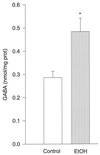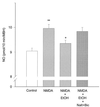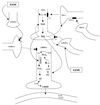Inhibitory pathways and the inhibition of luteinizing hormone-releasing hormone release by alcohol
- PMID: 10688896
- PMCID: PMC15802
- DOI: 10.1073/pnas.040569597
Inhibitory pathways and the inhibition of luteinizing hormone-releasing hormone release by alcohol
Abstract
In this research we examined the mechanisms by which ethanol (EtOH) inhibits luteinizing hormone-releasing hormone (LHRH) release from incubated medial basal hypothalamic explants. EtOH (100 mM) stimulated the release of two inhibitory neurotransmitters: gamma-aminobutyric acid (GABA) and beta-endorphin. EtOH also inhibited NO production, indicative of a suppression of nitric oxide synthase (NOS) activity. This inhibition was reversed by naltroxone (10(-8) M), a micro-opioid receptor blocker, indicating that the inhibition of NOS by EtOH is mediated by beta-endorphin. EtOH also blocked N-methyl-d-aspartic acid-induced LHRH release, but the blockade could not be reversed by either the GABA receptor blocker, bicuculline (10(-5) M), naltroxone (10(-8) M), or both inhibitors added together. However, increasing the concentration of naltrexone (10(-6) M) but not bicuculline (10(-4) M) reversed the inhibition. When we lowered the concentration of EtOH (50 mM), the EtOH-induced blockade of LHRH release could be reversed by either bicuculline (10(-5) M), naltroxone (10(-8) M), or the combination of the two blockers. Therefore, GABA is partially responsible for the blockade of N-methyl-d-aspartic acid-induced LHRH release. The block by GABA was exerted by inhibiting the activation of cyclooxygenase by NO, because it was reversed by prostaglandin E(2), the product of activation of cyclooxygenase. Because the inhibition caused by the higher concentration of EtOH could not be reduced by bicuculline (10(-4) M) but was blocked by naltroxone (10(-6) M), the action of alcohol can be accounted for by stimulation of beta-endorphin neurons that inhibit LHRH release by inhibition of activation of NOS and stimulation of GABA release.
Figures









References
-
- Cicero T J, Badger T. J Pharmacol Exp Ther. 1977;201:427–433. - PubMed
-
- Cicero T J, Newman K S, Gerrity M, Scumoker P F, Bell R D. Life Sci. 1982;31:1587–1596. - PubMed
-
- Mendelson J H, Mello N K, Ellingboe J. Exp Ther. 1977;202:676–682. - PubMed
-
- Dees W L, Rettori V, Kozlowski G P, McCann S M. Alcohol. 1985;2:641–646. - PubMed
Publication types
MeSH terms
Substances
Grants and funding
LinkOut - more resources
Full Text Sources

